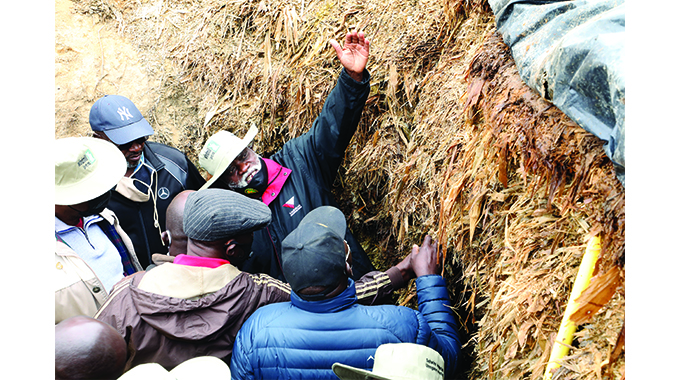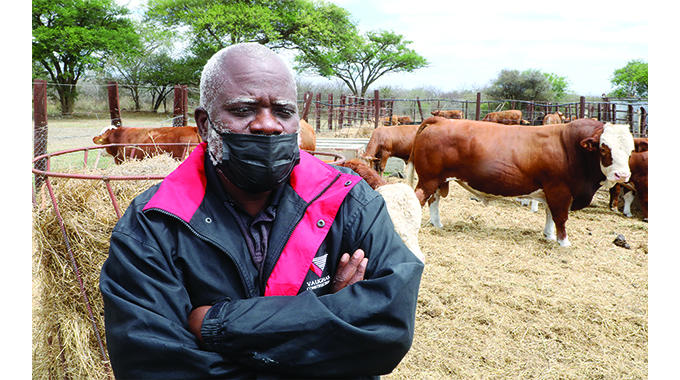WATCH: ‘Small herds can pay big’

Sukulwenkosi Dube-Matutu, Chronicle Reporter
Esigodini-based cattle breeder, Mr Obert Chinhamo says contributing to the success of the Livestock Growth Development Plan does not only require a farmer to have a large herd of cattle but also quality breed.
Mr Chinhamo who owns Biano Farm, boasts of being the only farmer in the southern part of the country with the rare, yet precious Simmental breed, which is known for its high quality meat and milk. The breed is also crucial for cross-breeding.
When crossing them with indigenous breeds, Simmentals help to improve the quality of cattle.
Mr Chinhamo has proved that the breed which originates from Europe can do well here and all that is needed is to ensure they have high quality feed among other requirements.

Simmentals breeder Mr Obert Chinhamo with part of his herd
Farmers yesterday converged at Biano Farm for a field day where they marvelled at the rich quality of Mr Chinhamo’s breed. Unlike the average cattle that weigh 150kgs, the Simmental’s average weight is about 500kgs with some of his bulls weighing about a tonne. During the field day, farmers were taught how to make silage, which is one of Mr Chinhamo’s major stockfeed for his animals.
Silage is one of the technologies used to preserve fodder, especially during the dry season. It helps to preserve nutrients in stockfeed.
Mr Chinhamo believes that the livestock sector can record huge successes if farmers focus on improving their animals through cross breeding. He has about 300 beasts he is breeding at his 80-hectare plot. His bulls sell for about US$6 000
Under the Livestock Recovery Plan, Government seeks to improve cattle genetics through harvesting of semen from bulls and distributing it across provinces. Growth of the livestock sector is key to the attainment of Vision 2030
In an interview after a tour of his farm, Mr Chinhamo said he started livestock farming in the early 1990s with a variety of breeds that he reared for commercial purposes.
He started breeding Simmentals in 2006.
“I decided to start breeding Simmentals because I felt it’s an animal that can bring value to anyone breeding them the world over. I see it as a dual animal because it doesn’t only offer dairy, but I also help other farmers who wish to improve their breeds under cross breeding projects,” he said.

“We have realised that land doesn’t grow, but we can keep reasonable herds even on small land by going intensive.
We are very intensive in terms of the way we produce. We grow crops that we use to make silage, which is enough to last us from May to December. That period is a very difficult time for cattle and we ensure that we have enough supplements for the animals.”
He said in addition to the silage that he produces for his cattle, he hires people to bale grass from other farms which he feeds to his animals.
Mr Chinhamo said farmers should strive to produce a medium framed animal which weighs around 500kgs. Farmers must improve the animals they are breeding in order to improve the quality of meat being produced.
“Statistics tell us that we have 5,5 million cattle. We could reduce the number to 2,5 million cattle, but producing the medium frame animal. The cattle farmers generally have a range of around 140kgs. This means we will carry the right amount of beef in the country, but with less animals. The less animals we carry means the country will serve a lot of money in importing things like drugs and vaccines,” he said.
Mr Chinhamo said cattle farming is a business that required one to do the right animal husbandry such as dipping and providing supplementary feed, among other things.
He said he had successfully managed to breed Simmentals over the years, which is an indication that they can do well in the Matabeleland region.
The conception rate of his animals is around 98 percent and he was targeting 100 percent. The national livestock conception rate is around 45 to 50 percent.
“We are working hard to get our cows to give us a calf per year. The reason we get such high figures is the value we attach to the nutrition of our animals. As bull breeders, we are breeding so that commercial players can buy bulls from us. As bull breeders, we are aiming to improve the national herd. This is seed stock from our country,” he said.
Mr Chinhamo, who is also president of the Simmental Simbrah Society of Zimbabwe, said a few people were involved in rearing the breed as they had less than 1 000 cattle combined nationally. He said more farmers, especially youths, must venture into cross breeding in order to improve the livestock sector.
Some breeds have gone extinct in the country hence the need for youths to be actively involved in reviving such breeds.
Speaking at the same field day, Matabeleland South provincial livestock specialist, Mr Hatitye Zondai, said farming projects like the one being pursued by Mr Chinhamo were crucial to the Livestock Recovery Plan.
“This is important to us as Government because it’s inline with the Livestock Recovery Plan whereby we want to improve the cattle genetics by harvesting semen and distributing it across the provinces. Mr Chinhamo’s farm can be one of the centres where we can harvest the semen for distribution. The centre that has been identified so far is in Mazowe, but we are saying it can be decentralised here for easy access to farmers,” said Mr Zondai.
Animal Health Expert Dr Nhamo Nyanhongo said Simmental was an exotic breed that is well muscled, grows fast and produces a lot of beef.
He said Simmentals form a good basis for crossing with indigenous breeds.
There were fewer breeders of Simmental in the country and Dr Nyanhongo urged more farmers to consider taking up the breed. He also urged farmers to pay attention to the nutrition of their animals so that they produce a calf each year.
He also said silage making was a very important way of preserving nutrition value of vegetation for livestock since Zimbabwe has a long dry season, which causes vegetation to lose its nutrition. – @DubeMatutu









Comments